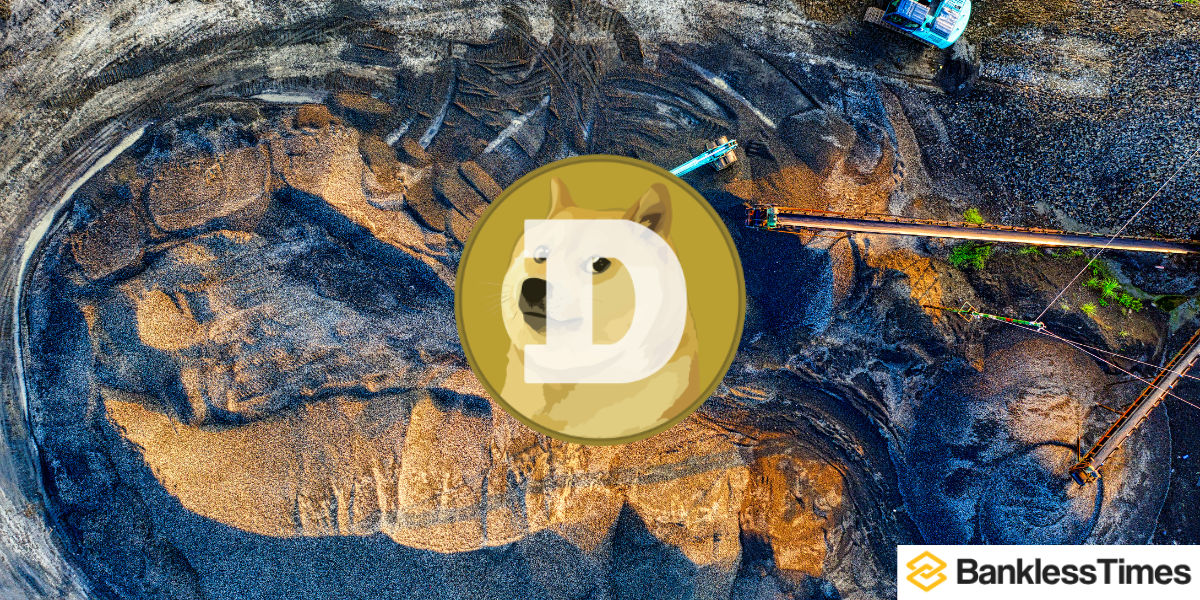Interested in mining Dogecoin, the wildly popular meme-inspired cryptocurrency? You’ve come to the right place. As someone who has been actively involved in the crypto mining world for over 5 years, including mining Dogecoin myself, I’m going to share my tips on how to mine Dogecoin in 2024.
By the end of this guide, you will be equipped with everything that you need to know to start earning crypto through mining.
Having tested dozens of different mining rigs and methods, this guide will dive into what works and my top tips for maximizing your earning potential.
Key Takeaways
- Dogecoin uses a proof-of-work mining model requiring specialized ASIC or GPU hardware.
- Mining profitability hinges on your hardware costs, energy efficiency, and the DOGE market price.
- There are three main approaches: solo mining, joining a pool, and cloud mining services.
- Dogecoin currently has a relatively lower mining difficulty compared to Bitcoin.
- You can start mining Dogecoin at home by buying an ASIC miner, connecting to a pool, downloading the required software and running the system.
What Is Dogecoin Mining?
Dogecoin mining refers to the process of using high-powered computer hardware to secure the Dogecoin blockchain network and validate new transactions in exchange for newly minted DOGE token rewards.
Like Bitcoin mining, Dogecoin leverages a proof-of-work (PoW) consensus model where miners compete to solve extremely complex mathematical equations and achieve the next valid “hash”.
Miners essentially lend their computing power in a decentralized way to process and validate groups of transactions, known as blocks.
Solving the cryptographic puzzle to produce a valid block hash that meets Dogecoin’s current mining difficulty target allows that miner to mint the next block. As a reward, they receive a set amount of newly created DOGE tokens plus any transaction fees paid by users sending DOGE.
How much does a Dogecoin miner make?
According to statistics from BitInfoCharts, Dogecoin’s current block reward is 10,000 DOGE every time a new block is mined, which occurs roughly once per minute on average. These block rewards, combined with transaction fees, act as incentives for miners to contribute their costly mining rigs and electricity towards securing the Dogecoin network.
Is Dogecoin mining difficult?
The total computing power or “hashrate” provided by all miners globally determines how difficult it is to solve valid hashes and earn the next block reward.
As more miners join the network, the difficulty automatically adjusts to ensure a steady, consistent rate of new block production and issuance of new DOGE into circulation.
While Dogecoin was initially created as a fun, lighthearted parody of Bitcoin, Dogecoin mining plays a crucial role in enabling the decentralized, peer-to-peer transfer of DOGE tokens on its blockchain network in a secure and verifiable manner without third-party intermediaries.
How To Mine Dogecoin
Now that you understand what Dogecoin mining is, let’s jump straight into how to do it.
In the following guide, I will walk you through how to mine dogecoin using hardware or software.
Step 1: Buy Mining Hardware
The first major step to mining Dogecoin is obtaining the right mining hardware setup. For DOGE, the ideal mining rigs utilize application-specific integrated circuit (ASIC) chips optimized for the cryptocurrency’s Scrypt mining algorithm.
Based on data from the mining consultants at Braiins, two of the most profitable and efficient Dogecoin ASIC miners currently available are:
- ElphaPex DG1 Dogecoin Miner
- Bitmain Antminer L7 (9.5Gh)
However, for those looking to get started on a smaller scale, graphics processing units (GPUs) can still reasonably mine DOGE, though at lower profit margins. Some of the more capable GPU models for mining include SAPPHIRE Pulse Radeon RX 580, Nvidia GeForce GTX and ASUS RX Vega 64.
It’s important to carefully calculate the specific mining profitability of any potential rig based on its hash rate capability, power consumption, and upfront cost compared to the revenue you can expect from DOGE mining rewards.
Step 2: Download Mining Software
Once you have your desired mining rig, the next step is installing compatible mining software to actually run the DOGE mining operations.
There are several quality options to choose from based on your hardware setup:
- For ASIC miners, CGMiner and BFGMiner are two of the most widely used and reliable mining programs
- For GPU miners, popular software choices include WinMiner, EasyMiner, and NiceHash
- For those interested in cloud mining, most reputable services like NiceHash and WinMiner offer user-friendly mining applications
When evaluating potential mining programs, key factors to consider are user-friendliness, ability to over/underclock your hardware, monitoring tools, and compatibility with your preferred mining pool if not solo mining.
Step 3: Choose Mining Method
Speaking of mining pools, there are three primary approaches you can take for actually mining Dogecoin once you have your hardware and software:
1) Solo mining on your own
2) Joining an existing DOGE mining pool
3) Utilizing a cloud mining service
We’ll compare the pros and cons of each method in more detail below.
Step 4: Connect to Mining Pool (Optional)
If you decide to join one of the many public mining pools for Dogecoin, you’ll need to connect your mining hardware and software to the pool based on their setup instructions.
Some of the largest and most popular DOGE mining pools to consider include:
- Litecoinpool.org
- F2Pool
- ViaBTC
- Prohashing
- Zergpool
Each pool has thorough documentation on their website for how to properly connect and point your mining rig to their pool’s servers. You’ll also need to create an account with a pool username to have your shares properly tracked and paid out.
Set Up Wallet
Regardless of whether you decide to solo mine or join a mining pool, you’ll need a crypto wallet to store any Dogecoin mining rewards you earn.
While you can use standard software wallets like Dogechain, MultiDoge, or the official Dogecoin Core wallet, I’d recommend utilizing a secure hardware wallet like a Ledger or Trezor model.
Hardware wallets allow you to store your crypto offline in “cold” storage for maximum security. They can interface with mining pool websites and apps to automatically receive payouts to your unique wallet address.
Step 5: Start Mining DOGE
Once you’ve assembled your mining rig, downloaded the necessary software, selected your mining method, connected to a pool (if applicable), and set up your wallet, you’ll finally be ready to start mining Dogecoin!
Simply run your selected mining program and let it get to work – your hashrate and active workers should show up in the user interface. If configured properly, you’ll start seeing DOGE rewards accumulate in your wallet over time.
Monitor your rig’s temperature and performance consistently, and make any overclocking or undervolting adjustments as needed to optimize for maximum efficiency.
Consistent monitoring is key to maximizing Dogecoin mining profits.
Ways To Mine Dogecoin
You can mine DOGE using one of three ways each with its upsides and downsides:
Solo Mining
Solo mining refers to mining entirely independently with just your personal mining rig or rigs, without joining any pools.
The primary advantage of this method is that you keep 100% of any mining rewards you generate – no need to share with a pool.
However, the big downside to solo DOGE mining is the randomized nature of mining. You’ll likely go extended periods without actually mining any blocks and earning rewards at all, since you’re operating with such a small fraction of the overall network hashrate.
While solo miners occasionally get lucky strikes, solo mining Dogecoin is extremely high-risk compared to pool mining and is generally only advisable if you have a very large-scale mining operation.
For that reason, most DOGE miners opt for pool mining.
Joining a Mining Pool
When you join one of the many Dogecoin mining pools available, you coordinate your mining hashrate along with hundreds or thousands of other individual miners. The combined pool then shares any mining rewards earned proportionally among miners based on their contributed hash power.
The main benefit of pool mining is that it provides much more frequent, consistent payouts over consistent periods of time compared to the randomized, all-or-nothing nature of solo mining.
You may keep a smaller percentage of each reward due to pool fees, but you earn a steadier stream of Dogecoin.
Most reputable DOGE mining pools charge fairly low fees in the range of under 4% of rewards to cover their operational costs. They make mining far more accessible for casual miners and small DOGE mining rigs.
Cloud Mining
The third option for how to mine Dogecoin is cloud mining through a third-party service provider like NiceHash or WinMiner.
Cloud mining involves renting hashing power from the service’s datacenter mining rigs rather than operating any hardware directly yourself.
The key advantage of cloud mining is avoiding the large upfront cost and maintenance hassles of purchasing your own physical mining rig.
The downside is that you have recurring rental fees that eat into your mining profits. Most experts agree cloud mining is typically only cost-effective and profitable at fairly large scales where the math works out.
Why Mine Dogecoin?
While Dogecoin was created initially in 2013 as a fun, tongue-in-cheek parody of Bitcoin, it has grown into one of the largest and most popular cryptocurrencies.
DOGE has an active community of users and supporters behind it, including influential figures like Elon Musk who have helped drive its adoption. Here are some of the key reasons why mining Dogecoin might appeal to you:
Lower Barrier to Entry
Compared to mining Bitcoin or other major proof-of-work cryptocurrencies, Dogecoin has a significantly lower mining difficulty.
This makes it more feasible for individuals to mine DOGE profitably with more modest hardware setups like GPU rigs.
Revenue Potential
While Dogecoin isn’t nearly as valuable per coin as Bitcoin, its active usage and trading provides the potential to earn real income through mining efforts.
As DOGE adoption continues rising, so does the potential mining revenue.
Active Community
Dogecoin has cultivated one of the most active and engaged crypto communities out there.
From online forums to development groups, there are many ways miners can get involved, share tips, and be part of the DOGE movement.
Just for Fun
Let’s not forget that at its core, Dogecoin is meant to be an enjoyable crypto experience. For many enthusiasts, mining DOGE provides a fun way to learn about blockchain technology hands-on and be part of the meme-inspired mission.
Is Dogecoin Mining Profitable?
The big question on every prospective Dogecoin miner’s mind is: Can I actually make money mining DOGE?
The short answer is that, yes, Dogecoin mining can absolutely be profitable. However, your profit potential depends heavily on several key variables:
Mining Hardware
The specific mining rig you use makes a huge difference. More powerful ASIC miners like Antminers can achieve very high hashrates for maximum rewards. Older GPU rigs will make far less on a daily basis.
Electricity Costs
Mining rigs require heavy electricity usage for running the hardware around the clock. If you pay high residential electricity rates, that can eat significantly into mining profits. Miners in areas with cheap power have a major advantage.
Dogecoin Price
Like any cryptocurrency, the price DOGE is currently trading at has a direct impact on your mining revenue. When the DOGE price is booming, the same mining payouts are worth substantially more.
Mining Difficulty
As the DOGE mining difficulty rises due to more miners joining, each individual miner earns smaller rewards per unit of hashpower contributed. You need to constantly weigh difficulty against your electricity costs.
By taking all of these factors into account and using one of the many Dogecoin mining calculators available, you can estimate your projected daily profits from mining DOGE.
For example, let’s say you purchased a used Antminer L3+ ASIC for around $80 used. This miner can achieve around 550 MH/s at 620W power draw. In a relatively cheap $0.10/kWh electricity area, you’d pay around $1.48 per day in power costs.
According to the mining calculator at NiceHash, this rig should generate around $2.42 worth of DOGE per day at current prices and difficulty after electricity costs. That’s a decent $75 per month profit, returning your hardware cost in just over a month!
How Many Dogecoins Do Miners Earn?
There is no fixed amount of Dogecoin that each individual miner can expect to earn consistently. Rewards fluctuate depending on several factors:
- Mining Rig Hashrate: Miners with higher hashrate rigs like ASICs will earn larger shares of pooled mining rewards compared to lower hashrate GPUs.
- Overall Network Hashrate: The higher the global Dogecoin network hashrate from all miners collectively, the smaller each individual miner’s relative share of rewards.
- Transaction Volume: In addition to block rewards, miners earn a portion of any transaction fees paid by DOGE senders. Higher overall transaction volume allows for higher fee payouts.
- Block Reward Amount: Dogecoin’s code is designed to award fixed amounts of new DOGE per block to control issuance and inflation. That per-block reward amount is subject to change over time.
How Difficult Is It To Mine Dogecoin?
Dogecoin’s current mining difficulty of around 3.81M is substantially lower than Bitcoin’s difficulty level over 30T. However, that doesn’t mean Dogecoin mining is easy by any means.
The mining difficulty score represents how much combined computational power is required from all miners to achieve the target rate of new block production.
As more miners join the Dogecoin network with more collective hashrate, the difficulty automatically increases to throttle block timing appropriately.
For some context, while Dogecoin’s difficulty of 3.81M sounds low compared to BTC, it has still increased by over 10x in just the past year. So mining is becoming more competitive and requires progressively more powerful hardware to profitably participate.
How Long Does It Take To Mine 1 Dogecoin?
The Dogecoin network adds 1,440 new blocks every day, which translates to one new block on average per minute. Each of these blocks has a set reward of 10,000 Dogecoin, making it impossible to mine only one DOGE.
While the average time to mine one DOGE is a minute, this can vary depending on the hash rate and the difficulty of the mining process. For example, using a CPU with a hash rate of 20 kH/s and around 100 Watts of power consumption would take at least 1,325 days to earn one coin.
In contrast, using a high-spec ASIC device like the Bitmain Antminer L7 9500Mh/s can mine one DOGE in a very short time due to its high hash rate.
Overall, the time it takes to mine one Dogecoin is highly dependent on the specific mining setup and the current mining conditions.
Final Thoughts
Mining Dogecoin is one way to earn income with cryptocurrency in 2024. In this guide, I have shared how to mine Dogecoin with a mining rig and discussed some top tips to get started.
Dogecoin mining is considerably easier than Bitcoin mining, which makes it a good gateway into the mining world. However, profits can be slow and crypto mining comes with risk.
Before you get started with Dogecoin mining, consider whether you can afford the high electricity costs that come with running a rig.
FAQs
Is it possible to mine Dogecoin?
Yes, absolutely! While initially starting as a parody, Dogecoin utilizes the same proof-of-work mining model as Bitcoin, Litecoin, and other major cryptocurrencies. Anyone can participate in mining Dogecoin with the right hardware and software setup.
Can I mine Dogecoin on my phone?
Unfortunately, no – smartphones and mobile devices lack the processing power and cooling capabilities required for viable cryptocurrency mining. You need dedicated mining hardware like ASICs or high-end GPUs to reasonably mine DOGE or other cryptos.
Is Dogecoin mining environmentally friendly
Dogecoin mining requires significant energy like all cryptocurrency mining. However, some mining operations use renewable energy sources to mitigate environmental impact.
Which miner is best for Dogecoin?
The best miner for Dogecoin depends on several factors such as your budget, available space, and the level of noise and heat you are willing to tolerate. Among the current ASIC options optimized for DOGE’s mining algorithm, the Elphapex DG1+, Bitmain Antminer L7 and Innosilicon A2 Terminator models offer the highest hashrates and overall efficiency for Dogecoin mining. For GPU mining, AMD cards like the RX 570/580 tend to perform best.
How much Dogecoin can I mine in a day?
The amount of DOGE you can potentially mine per day ranges from just fractional Dogecoins with basic entry-level mining rigs up to thousands of DOGE with powerful, ASIC mining farms. It depends heavily on your hardware hashrate compared to the network difficulty. According to CoinWarz data the ElphaPex DG1+ miner can mine 5.9 DOGE/hour which adds up to roughly 142 DOGE daily.










